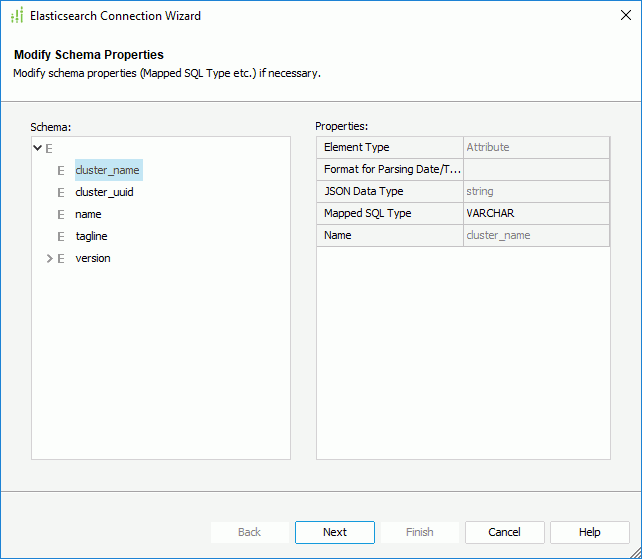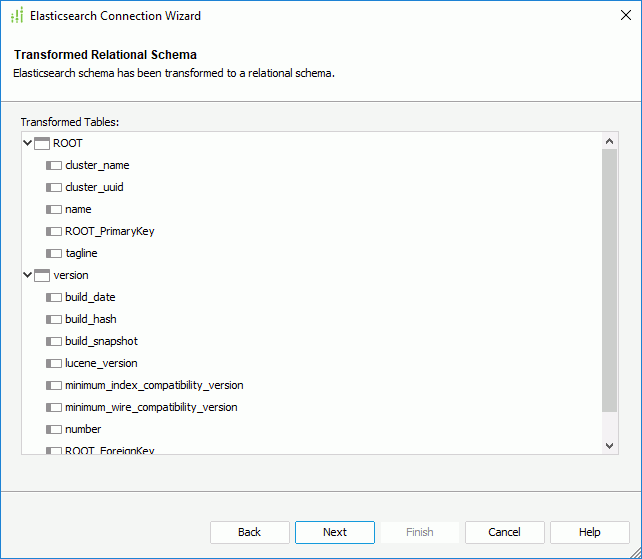Accessing Data via Elasticsearch Connections
An Elasticsearch connection contains relational data that is transformed from an Elasticsearch data source. This topic describes how you can set up Elasticsearch connections in a catalog, and add and manage tables transformed from the Elasticsearch data sources in the catalog via the connections.
This topic contains the following sections:
- How Designer Gets Data from Elasticsearch Data Sources
- Setting Up Elasticsearch Connections in a Catalog
- Adding More Tables to an Elasticsearch Connection
- Managing Tables in an Elasticsearch Connection
How Designer Gets Data from Elasticsearch Data Sources
Designer gets data from Elasticsearch data sources in the same way as it gets data from JSON data sources.
Setting Up Elasticsearch Connections in a Catalog
To set up an Elasticsearch connection to connect a catalog to an Elasticsearch data source, take the following steps:
- Create a catalog or open a catalog.
- In the Catalog Manager, do either of the following:
- To set up the connection in an existing data source in the catalog, right-click the data source node and select New Elasticsearch Connection from the shortcut menu.
- To set up the connection in a new data source in the catalog, select any of the existing catalog data sources, select New Data Source on the Catalog Manager toolbar, then in the New Data source dialog box, specify the name of the data source, select the Elasticsearch connection type and select OK.
Designer displays the Elasticsearch Data Source Options dialog box.

- Specify the URL, user name, and password with which to connect to the Elasticsearch data source.
- To get data from the Elasticsearch data source by the request body, select Use Request Body Search and specify the request body. You can reference parameters and constant level formulas predefined in the catalog data source in which you create the Elasticsearch connection, and the User Name special field in the URL and the request body in the same way as in aggregation pipeline expressions.
- To get data from the Elasticsearch data source by the Scroll API, select Scroll and specify how long the Scroll API will keep the search context alive. For more information about the Scroll API, go to www.elastic.co/guide/en/elasticsearch/reference/current/search-request-scroll.html.
- When you reference parameters and formulas in the URL or request body, you can select Edit Format to edit the format of their values.
- Select OK. Designer displays the Elasticsearch Connection Wizard dialog box.

- In the Modify Schema Properties screen, Designer displays the elements in the Elasticsearch schema in the Schema box. You can select an element and modify its properties in the Properties box.
- Select Next. Designer displays the Transformed Relational Schema screen, showing the relational tables it builds based on the transformed relational schema structure.

- Select Next. Designer displays the Add Table screen.

- In the Tables box, select the tables you want to use in the connection and select Add
 to add them to the Added Tables box. You can create queries and business views using these tables and then develop reports based on the queries and business views.
to add them to the Added Tables box. You can create queries and business views using these tables and then develop reports based on the queries and business views. - Select Finish to complete the transformation process.
Adding More Tables to an Elasticsearch Connection
After you have created an Elasticsearch connection in a catalog, you can add more tables transformed from the Elasticsearch data source into the catalog via the connection.
To add more tables to an existing Elasticsearch connection
- Do one of the following:
- Right-click the Elasticsearch connection and select Add Tables from the shortcut menu.
- Right-click the Tables node of the Elasticsearch connection and select Add Tables from the shortcut menu.
- Right-click an existing table in the Elasticsearch connection if there is and select Add Tables from the shortcut menu.
- Right-click any folder in the Tables node of the Elasticsearch connection if you have already created some and select Add Tables from the shortcut menu.
- Select the Tables node of the Elasticsearch connection, or any existing table or folder in the connection and select Add Tables on the Catalog Manager toolbar.
Designer displays the Add Tables dialog box.

- Select Refresh.
- Designer displays the tables in the schema that it transforms from the Elasticsearch data source in the Tables box. Choose the required tables and select Add.
- After adding the required tables, select Done to close the dialog box.
Managing Tables in an Elasticsearch Connection
For the tables you have transformed from an Elasticsearch data source and added into a catalog via an Elasticsearch connection, you can refresh them, organize them into folders, and remove and add the table columns the same as you do with tables from a JDBC database.
 Previous Topic
Previous Topic
 Back to top
Back to top